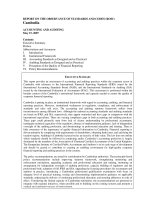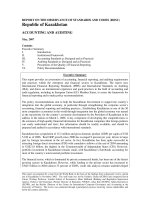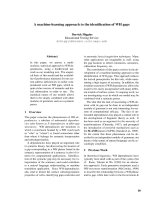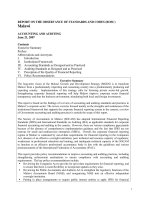Proteomics approach on the identification of virulence factors of enteropathogenic and enterohemorrhagic escherichia coli (EPEC and EHEC) and further characterization of two effectors espb and nlei
Bạn đang xem bản rút gọn của tài liệu. Xem và tải ngay bản đầy đủ của tài liệu tại đây (3.3 MB, 180 trang )
PROTEOMICS APPROACH ON THE IDENTIFICATION OF
VIRULENCE FACTORS OF ENTEROPATHOGENIC AND
ENTEROHEMORRHAGIC ESCHERICHIA COLI (EPEC AND EHEC)
AND FURTHER CHARACTERIZATION OF TWO EFFECTORS:
ESPB AND NLEI
BY
LI MO (M. SC.)
A THESIS SUBMITTED
FOR THE DEGREE OF DOCTOR OF PHILOSOPHY
DEPARTMENT OF BIOLOGICAL SCIENCES
NATIONAL UNIVERSITY OF SINGAPORE
2006
i
ACKNOWLEDGEMENTS
I wish to express my heartfelt gratitude to my main supervisor, Professor Hew Choy
Leong for his care and guidance. His clement character and esteemed research passion
inspirit me through my study. I wish to express my heartful thanks to my co-supervisor,
Associate Professor Leung Ka Yin for his supervision and advice. He had planned
properly and provided many opportunities for my research. I would sincerely thank
Professor Ilan Rosenshine from the Hebrew University, Israel, for his sound instruction
and generous sharing of ideas and experiences.
My Special thanks will also go to my PhD. Committee members. Thank you for spending
so much time in reviewing my thesis and audit my presentation. I would like to take this
opportunity to thank Dr. Lin Qingsong, Dr. John Foo, Ms Wang Xianhui and Ms Kho
Say Tin from the Protein and Proteomics Center for their kind assistance in mass
spectrometry, protein sequencing and data analysis. Further thank goes to Mr. Shashikant
Joshi for his reviewing and suggestions on my thesis.
My appreciation also goes to my previous and present lab members: Dr Yu Hongbing,
Dr Seng Eng Khuan, Dr Srinivasa Rao, Dr Tan Yuan Peng, Dr Yamada, Dr. Li Zhengjun,
Dr. Xie Haixia , Ms Tung Siew Lai, Mr. Zheng Jun, Mr. Peng Bo, Mr. Zhou Wenguang,
Ms Tang Xuhua, Mr. Liu Yang, Mr. Wang Fan, Mr. Chen Liming, for their
encouragement, help, assistance and company.
I would also like to thank my good friends Wang Xiaoxing, Hu Yi, Qian Zuolei, Sheng
Donglai, Luo Min, Tu Haitao, Sun Deying, Alan John Lowton. I appreciate their
friendship and their valuable suggestions, advice and help throughout my study. My
fellow labmates and other friends who have helped me one-way or another during the
course of my project are also greatly appreciated.
Last, but not least, I would like to thank my family members, my father, my mother and
my sister, who are always standing by me to give their utmost support. Their courage and
consolidation is the most powerful strength and is never separated by the distance, which
company me throughout my PhD process.
ii
TABLE OF CONTENTS
ACKNOWLEDGEMENTS·····························································································i
TABLE OF CONTENTS································································································ii
LIST OF PUBLICATIONS RELATED TO THIS STUDY········································ix
LIST OF FIGURES ········································································································ x
LIST OF TABLES ·······································································································xiii
LIST OF ABBREVIATIONS······················································································xiv
SUMMARY ··················································································································xvi
Chapter I. Introduction ··································································································1
I.1. Escherichia coli-the opportunistic infectious pathogen······································2
I.1.1. Pathogenic E. coli··························································································· 2
I.1.2. Epidemiology of EPEC ··················································································5
I.1.3. Epidemiology of EHEC ·················································································6
I.2. Pathogenesis and virulence factors of EPEC and EHEC··································· 7
I.2.1. EPEC pathogenesis and virulence factors····················································8
I.2.1.1. Attaching and effacing histopathology ·················································· 8
I.2.1.2. Localized Adherence (LA) and Bundle Forming Pili (BFP) ·············· 10
I.2.1.3. EAF plasmids ························································································ 11
I.2.1.4. Invasion·································································································· 12
iii
I.2.1.5. Flagella··································································································· 13
I.2.1.6. Serine Protease - EspC··········································································14
I.2.1.7. Heat-stable enterotoxin (EAST1).························································ 14
I.2.2. EHEC pathogenesis and virulence factors ·················································15
I.2.2.1. Shiga toxin ····························································································· 15
I.2.2.2. Intestinal adherence factors ································································· 16
I.2.2.3. Invasion·································································································· 17
I.2.2.4. Flagella··································································································· 18
I.2.2.5. pO157 plasmid······················································································· 19
I.2.2.6. Serine protease ······················································································19
1.2.2.6.1. EspP ································································································ 19
I.2.2.6.2. StcE ································································································· 20
I.2.2.7. Heat-stable enterotoxin (EAST1).························································ 21
I.2.2.8. Iron transport.······················································································· 22
I.2.3. Type Three Secretion System (TTSS) in EPEC and EHEC ····················· 22
I.2.3.1. Pathogenicity island (PAI)···································································· 23
I.2.3.2. Components of TTSS in EPEC and EHEC ·········································24
I.2.3.2.1. Components of TTSS basal body ·················································· 25
I.2.3.2.2. TTSS translocators········································································· 26
I.2.3.2.3. LEE encoded adhesin····································································· 27
I.2.3.2.4. LEE encoded TTSS regulators······················································29
I.2.3.2.5. Switches of TTSS translocators and effectors ······························29
I.2.3.3.6. TTSS chaperons ············································································· 30
iv
I.2.3.3.7. TTSS secreted Effectors································································· 30
I.3. Objectives ············································································································ 33
Chapter II. Common materials and methods······························································ 35
II.1. Common used medium and buffer··································································· 35
II.2. Bacteria strains and plasmids···········································································35
II.3. Tissue culture····································································································· 35
II.4. Molecular biology techniques··········································································· 36
II.4.1. Genomic DNA isolation··············································································36
II.4.2. Cloning DNA fragments and transformation into E. coli cells················36
II.4.3. Analysis of plasmid DNA ··········································································· 37
II.4.4. Plasmid DNA isolation and purification ···················································37
II.4.5. DNA sequencing ························································································· 38
II.4.6. Sequence analysis ······················································································· 38
II.4.7. Southern hybridization ··············································································39
II.5. Protein techniques····························································································· 40
II.5.1. Preparation of ECPs from E. coli strains ·················································40
II.5.2. Sodium dodecyl sulfate-polyacrylamide gel electrophoresis (SDS-PAGE)
································································································································ 40
II.5.3. Visualization of protein bands/spots (Coomassie blue staining and silver
staining)··················································································································41
II.5.4. Western blotting ························································································· 42
v
Chapter III. Comparative proteomics analysis of extracellular proteins of
enterohemorrhagic and enteropathogenic Escherichia coli and their ······················· 44
Abstract······················································································································ 45
III.1. Introduction ····································································································· 46
III.2. Materials and methods ···················································································· 48
III.2.1. Bacterial strains and culture conditions·················································· 48
III.2.2. Proteins isolation and assay······································································ 49
III.2.3. One- and two-dimensional gel electrophoresis········································49
III.2.4. Tryptic in-gel digestion and MALDI-TOF MS analysis························· 50
III.3. Results and discussion ····················································································· 51
III.3.1. ECP production ························································································ 51
III.3.2. Extracellular Proteomes of EHEC and EPEC········································59
III.3.3. Identification of Ler and IHF regulated proteins··································· 63
III.3.4. Applications and conclusions ··································································· 67
Chapter IV. Characterization of EspB as a translocator and an effector and its
involvement in EPEC autoaggregation········································································ 68
Abstract······················································································································ 69
IV.1 Introduction ······································································································ 70
IV.2. Materials and methods ···················································································· 72
IV.2.1. Bacterial strains and plasmids ································································· 72
IV.2.1. Fractionation of infected HeLa cells ························································ 73
IV.2.2. Invasion assay····························································································73
vi
IV.2.3. Examination of bacterial surface exposed structure by transmission
electron microscopy (TEM) ·················································································· 74
IV.2.4. Phase contrast microscopy ······································································· 74
IV.2.5. Construction of plasmid for expression of EspB-TEM and β-lactamase
based translocation assay······················································································ 75
IV.2.6. Edman N-terminal sequencing································································· 75
IV.3. Results···············································································································76
IV.3.1. Survey of the two forms of EspB······························································ 76
IV.3.2. Mutation of espB did not affect the secretion of other extracellular
proteins··················································································································· 77
IV.3.3. Mutation of espB mutant abolished the translocation of effectors ········ 80
IV.3.4. EspB is translocated into infected HeLa cells·········································· 80
IV.3.5. EspB is involved in the autoaggregation·················································· 83
IV.3.6. EspB mutant does not form the autoaggregation ··································· 83
IV.3.7. ∆espB mutant showed less extracellular filamentous appendages········· 86
IV.3.8. ∆espB mutant has lower invasion ability ················································· 87
IV. 4. Discussion ········································································································89
IV. 5. Conclusion ······································································································· 92
Chapter V. Identification and Characterization of NleI, a New Non-LEE-encoded
Effector of Enteropathogenic Escherichia coli (EPEC) ·············································· 93
Abstract······················································································································ 94
V.1. Introduction ·······································································································95
vii
V.2. Material and methods ······················································································· 98
V.2.1. Bacteria strains and culture conditions····················································· 98
V.2.2. Tissue culture conditions············································································ 98
V.2.3. Construction of deletion mutants and plasmids ······································· 98
V.2.4. Flow cytometric analysis ············································································ 99
V.2.5. 2-D SDS-PAGE and proteomics ······························································ 100
V.2.6. Fractionation of infected HeLa cells························································ 100
V.2.7. Expression and Immunoblot analysis······················································ 101
V.2.8. Translocation assay ·················································································· 102
V.2.9. Fluorescence microscopy for observation of translocation, transfection
and actin condensation························································································ 102
V.3. Results ·············································································································· 106
V.3.1. Identification of NleI from EPEC sepL and sepD mutants ···················· 106
V.3.2. NleI is located within a prophage-associated island in EPEC ··············· 107
V.3.3. NleI is a secreted protein and the secretion of NleI is TTSS-dependent113
V.3.4. NleI is translocated into the host cells ····················································· 116
V.3.5. CesT is involved in the translocation but not the stabilization of NleI · 119
V.3.6. NleI is localized in the host cytoplasm and membrane ·························· 119
V.3.7. NleI is regulated by SepD but not regulated by Ler and SepL at the
transcriptional level····························································································· 124
V.3.8. NleI is not involved in the filopodia and pedestal formation ················· 125
V.4. Discussion········································································································· 128
V.5. Conclusion········································································································ 130
viii
Chapter VI. General conclusions and future directions ··········································· 132
VI.1. General conclusions ······················································································· 132
VI.2. Future directions···························································································· 134
Reference ····················································································································· 137
ix
LIST OF PUBLICATIONS RELATED TO THIS STUDY
1. Li, M., I. Rosenshine, S.L. Tung, X.H. Wang, D. Friedberg, C.L. Hew, and K.Y.
Leung. 2004.
Comparative proteomics analysis of extracellular proteins of
enterohemorrhagic and enteropathogenic Escherichia coli and their ihf and ler
mutants. Appl. Environ. Microbiol. 70:5274-5282.
2. Li, M., I. Rosenshine, H.B. Yu, C. Nadler, E. Mills, C.L. Hew, and K.Y. Leung.
Identification and characterization of NleI, a new non-LEE-encoded effector of
enteropathogenic Escherichia coli (EPEC). (Microbes and Infection. 2006.
Accepted.)
3. Li, M., I. Rosenshine, and K. Y. Leung. Characterization of EspB as a translocator
and an effector and its involvement in EPEC autoaggregation. (In preparation)
x
LIST OF FIGURES
Fig. I.1.
Characteristic EPEC A/E lesion observed in the ileum after oral
inoculation of gnotobiotic piglets.
9
Fig. I.2.
Genetic organization of the EPEC / EHEC Locus of Enterocyte
Effacement (LEE) pathogenicity island.
10
Fig. I.3.
Schematic representation of the EPEC/EHEC type III secretion
apparatus.
28
Fig. III.1.
Growth and protein secretion of EHEC EDL933 and EPEC
E2348/69 in DMEM at 37
o
C with 5% (v/v) CO
2
.
52
Fig. III.2.
Comparison of ECP production among EHEC EDL933 and EPEC
E2348/69 wild type strains and their ler mutants.
53
Fig. III.3.
Extracellular proteins from EHEC EDL933. 54
Fig. III.4.
Extracellular proteins from EPEC E2348/69. 55
Fig. III.5.
Comparative proteome analysis of EHEC EDL933 wild type strain,
the ler mutant (DF1291) and ihf mutant (DF1292).
65
Fig. III.6.
Comparative proteome analysis of EPEC E2348/69 wild type strain,
the ler mutant (DF2) and ihf mutant (DF1).
66
Fig. III.7.
One-D SDS PAGE of the ECPs from EHEC EDL933 and EPEC
E2348/69 wild type strains, the ler mutants and ihf mutants.
66
Fig. IV.1.
Extracellular proteins (ECPs) from EPEC E2348/69 (a) and EHEC
EDL933 (b) treated with alkaline phosphatase.
77
Fig. IV.2.
Protein secretion of EPEC strains in DMEM at 37
o
C.
78
xi
Fig. IV.3.
Comparative proteomics analysis of ECP from EPEC E2348/69
wild type strain and the ∆espB mutant.
79
Fig. IV.4.
Western blot analysis of Triton X-100 insoluble and soluble
fractions of HeLa cells after infected with the EPEC wild type and
the ∆espB mutant and detected with anti-Tir antibody.
79
Fig. IV.5.
Demonstration of the translocation of EPEC EspB proteins into live
HeLa cells by using TEM-1 fusions and fluorescence microscopy.
82
Fig. IV.6.
Autoaggregation of EPEC in DEM culture is conferred by EspB. 84
Fig. IV.7.
Microscopic observation of EPEC demonstration of EPEC
E2348/69, ΔespB and ΔespB / pQEespB strains cultured in DMEM.
85
Fig. IV.8.
Transmission electron microscopy showed the extracellular
filamentous appendages of the EPEC wild type and ∆espB mutant.
86
Fig. IV.9.
EPEC espB mutant showed reduced ability to invade HeLa cells. 88
Fig. V.1.
Comparative analysis of the extracellular proteomes (ECPs) from
the EPEC wild type E2348/69, the sepL::Tn10 mutant, and the
∆sepD mutant.
109
Fig. V.2.
Graphic representation of the putative prophage-associated island
that contains NleI by comparing the EPEC E2348/69 and the E. coli
K12 MG1655 genomes.
110
Fig. V.3.
Southern blot analysis of genomic DNA from EPEC E2348/69,
Citrobacter rodentium DBS100 (CR), EHEC EDL933, and E. coli
K12 MG1655.
111
Fig. V.4.
Comparative proteome analysis of the ECPs from EPEC sepL::Tn10
mutant, sepL::miniTn10Kan ∆nleI mutant and sepL::miniTn10Kan
∆nleI / pACAYCnleI mutant.
112
Fig. V.5.
Western blot analysis of secreted proteins and total proteins of
EPEC E2348/69 wild type and the TTSS secretion mutant
escN::TnPhoA expressing pSAnleI-6His with anti-6His antibody.
114
xii
Fig. V.6.
NleI is secreted into the culture supernatant and translocated into
live HeLa cells in a TTSS-dependent manner.
115
Fig. V.7.
Demonstration of the translocation of EPEC effector proteins into
live HeLa cells by using TEM-1 fusion proteins.
118
Fig. V.8.
NleI is translocated by the EPEC wild type E2348/69 into HeLa
cells in a CesT-dependent manner.
121
Fig. V.9.
Western blot analysis of HeLa cell fractions after infection of the
EPEC E2348/69 wild type and the TTSS secretion mutant
escN::TnphoA expressing pSAnleI-6His.
122
Fig. V.10.
Confocal microscopy demonstrates that NleI is localized in the
cytoplasm and the nuclei of HeLa cells.
123
Fig. V.11.
Flow cytometric analysis of the GFP intensity of the EPEC wild
type E2348/69, ler::Kan, sepL::Tn10, and ∆sepD mutants, carrying
pDN-gfp or pDNnleI-gfp.
126
Fig.V.12.
NleI is not affecting actin condensation underneath the EPEC
infection sites.
127
xiii
LIST OF TABLES
Table II.1.
Bacterial strains and plasmid used in this study
43
Table III.1.
Bacteria strains used in this study
48
Table III.2.
Summary of the common extracellular proteins of EHEC and
EPEC identified by MALDI-TOF MS
56
Table III.3.
Summary of the specific extracellular proteins of EHEC and
EPEC respectively identified by MALDI-TOF MS
58
Table IV.1.
Bacteria strains and plasmids used in this study 72
Table V.1.
Bacteria strains and plasmids used in this study
104
Table V.2.
Oligonucleotides used in this study
105
xiv
LIST OF ABBREVIATIONS
1D one-dimensional
2D two-dimensional
aa amino acid
Amp
r
ampicillin-resistant
BCIP 5-bromo-4-chloro-3-indolyl phosphate
bp base pairs
BSA bovine serum albumin
CFU colony forming units
Cm centimeter(s)
Cm
r
chloramphenicol-resistant
ºC degree Celsius
DMEM Dulbecco's Modified Eagle Medium
DNA deoxyribonucleic acid
ECP extracellular protein
EDTA ethelyne diamine tetra acetic acid
FBS fetal bovine serum
g
gravitational force
HBSS Hank’s balanced salts solution
HEPES N-2-hydroxyethylpiperazine-N’-2-ethanesulfonic acid
IEF isoelectric focussing
IPTG isopropyl-thiogalactoside
kb kilobase
Kan
r
kanamycin-resistant
l litre(s)
LB Luria-Bertani broth
LBA Luria-Bertani agar
M molarity, moles/dm
3
MALDI matrix-assisted laser desorption ionization
MEM minimal essential medium
xv
mg milligram(s)
min Minute
ml milliliter(s)
mM milli moles/dm
3
MOI multiplicity of infection
NBT Nitro blue tetrazolium
orf open reading frame
OD optical density
% Percentage
PAGE Poly acrylamide gel electrophoresis
PBS phosphate buffered saline
PCR polymerase chain reaction
pI isoeletric point
PPD Primary Prtoduction Department
ppm parts per million
PVDF Polyvinylidene difluoride
s second
SDS sodium dodocyl sulfate
Tc
r
tetracycline-resistant
TE Tris-EDTA
TOF time-of-flight
TTSS type III secretion system
U unit(s)
µg microgram(s)
µl microlitre(s)
wt wild type
v/v volume per volume
w/v weight per volume
X-gal 5- bromo-4-chloro-3-indolyl-B-D-galactopyranoside
xvi
SUMMARY
Enteropathogenic and enterohemorrhagic Escherichia coli (EPEC and EHEC) are two
closely related human pathogens responsible for sever diarrhea in many countries. The
hallmark of infections caused by EHEC and EPEC is the attaching and effacing (A/E)
lesions on the epithelial cells. EPEC and EHEC utilize the type III secretion systems
(TTSSs) encoded on the locus of enterocyte effacement (LEE) to secrete and translocate
several effectors into host cells. The effectors may subvert the host signaling transduction
pathways and consequently cause diseases.
To further understand the pathogenesis and dissect the virulence of EPEC and EHEC, a
proteomics approach was used to analyze the extracellular protein (ECP) profiles of
EPEC, EHEC and their various mutants. Several common or strain specific virulence
factors identified from the extracellular proteomes of EPEC and EHEC indicate the close
relationship and variations between these two pathogens. Some novel proteins were also
identified by this proteomics approach, such as putative adhesins, secreted proteins and
phage related proteins. These novel proteins provided new candidates for exploiting
potential virulence factors of EPEC and EHEC.
One of the major secreted proteins, EspB, was found to have two dominant forms in
extracellular proteomics profiles of EPEC and EHEC. The two forms of EspB were
shown to remain unmodified at their N-terminus and they were unphosphorylated. With a
translocation signal at N-terminus, EspB was demonstrated to be an effector and to be
translocated into the host cells by TTSSs. By mutagenesis study, EspB was shown to be
xvii
involved in the EPEC aggregation and the ∆espB mutant has a lower invasion ability
when compared to the wild type. Transmission electron microscopy (TEM) showed that
EspB may affect the surface filamentous TTSS composition which may mediate the
bacteria cell interaction.
Furthermore, a putative effector, NleI, was identified from EPEC sepL and sepD mutants
by comparative proteomics study. NleI was found to be encoded outside the LEE region
and to exist in other A/E pathogens including EHEC and Citrobacter rodentium (CR).
The expression of NleI was found to be regulated by SepD at the transcriptional level.
After identifying the secretion and translocation signal at its N-terminal, NleI was
demonstrated to be translocated into HeLa cells in a TTSS dependent manner and the
translocation was facilitated by CesT. Using sub-cellular fractionation and fluorescence
microscopy, NleI was found to be localized in HeLa cell membrane and cytosol without
obvious cytotoxic effect. Fluorescent actin staining (FAS) indicated that NleI did not
affect the filopodia and pedestal formation of HeLa cells during infection.
This study has established a proteomics platform for accelerating the understanding of
EPEC and EHEC pathogenesis and identifying markers for laboratory diagnosis of these
pathogens. The discovery of new secreted proteins and new effectors by comparative
proteomics approach has provided valuable information on new virulence factors in
EPEC and EHEC. These results further supported the notion that EPEC and EHEC may
use multiple virulence factors to exploit the host cells and many factors may coordinate to
subvert different facets of host cellular processes.
1
Chapter I. Introduction
Microbial infection is one of the major causes of disease and mortality in humans.
Although infectious diseases have reduced the threat significantly due to improved
hygiene and sanitation, they are still a major public health problem worldwide. More
attention and efforts have been directed to study the mechanisms of infectious diseases
and to develop the diagnostic methods with particular emphasis on microbes. Among the
wide variety of infectious micro organisms, bacteria are problematic pathogens causing
many morbidity and mortality associated outbreaks around the world. The consequence
elicited by bacterial infections are diverse including food poisoning, diarrhea, meningitis,
lyme disease, pneumonia, tooth ache, anthrax
, and even some forms of cancers
(www.who.int). Diarrhea is one of the most important illness caused by enteric bacteria,
with over 2 million deaths occurring each year, particularly among infants younger than 5
years old (www.who.int). Much research has been focused upon the pathogensis of these
bacteria in order to understand their mechanisms of infection and to develop the
diagnostics and therapeutics for these pathogens. Enteropathogenic Escherichia coli
(EPEC) and enterohemorrhagic Escherichia coli (EHEC) are two of the most common
human pathogens which constitute a significant risk to human health worldwide. The
present study attempts to investigate and understand the pathogenesis of EPEC and
EHEC. Approaches for understanding the pathogenesis of EPEC and EHEC, which
involves studying the molecular and cellular basis of microbial pathogenesis and host-
pathogen interaction, are the major focuses.
2
I.1. Escherichia coli-the opportunistic infectious pathogen
Among the members of the normal micro biota of the human intestine, E. coli strains are
the predominant facultative anaerobic inhabitants of the intestines of all animals,
including humans. When aerobic culture methods are used, E. coli strains are the
dominant species found in feces. These organisms typically colonize the gastro-intestinal
tract within a few hours and interact with the hosts after settling down on certain sites.
Once established, E. coli strains may persist for months or years. Resident strains shift
over a long period (weeks to months), and more rapidly after enteric infection or
antimicrobial chemotherapy that perturbs the normal flora. Normally E. coli strains serve
useful functions in animal bodies by suppressing the growth of harmful bacterial species
and by synthesizing appreciable amounts of vitamins. Remaining harmlessly confined to
the intestinal lumen, E. coli strains usually interact with host cells to derive mutual
benefit. Most E. coli live inside the human gastro-intestinal tract without causing any
symptoms of disease. However, a minority of E. coli strains are capable of causing
human illness by several different mechanisms and are called “pathogenic E. coli”.
I.1.1. Pathogenic E. coli
Diseases caused by pathogenic E. coli are numerous and include urinary tract infections
(UTI), meningitis, diarrhea, wound infections, septicemia and even endocarditic disease.
A lot of efforts have been put on to identify pathogenic E. coli and there have been
significant advances in our understanding of the pathogenesis of E. coli infection.
Urinary tract infections are a serious health problem affecting millions of people each
year. Most infections of the urinary tract are caused by one type of bacteria called
3
uropathogenic E. coli (UPEC) and are by far the second most common type of bacteria
infection in the body (Foxman et al., 2000). UTI can range in severity from asymtomatic
through bacteriuria, cystitis and pyelonephritis. UPEC colonizes from the feces or
perineal region and ascend the urinary tract to the bladder. With the aid of specific
adhesins, such as type 1 fimbria, S fimbria, P fimbria and Dr family of adhesins, UPEC is
able to colonize the bladder
(Mulvey et al., 2000; Bahrani-Mougeot et al., 2002). To
acquire iron during or after colonization, UPEC produces siderophore and hemolysin and
utilizes the hemoglobin and heme released from lysed erythrocytes (Hantke et al., 2003).
These virulence factors function jointly causing the infection and inflammatory
symptoms in the urinary tract.
Meningitis is the inflammation of the membranes covering the brain and spinal cord.
Though multiple organisms may cause meningitis, E. coli is the leading agent responsible
for around 20% of the neonatal meningitis cases (Health et al., 2003). Meningitis is a
substantial cause of morbidity and mortality in neonates. Typically transmitted via
respiratory droplets, E. coli strains invade the blood stream of infants from the
nasopharynx or gastro-intestinal (GI) tract and are carried to the meninges where they
usually lead to infection of the meninges. The K1 E. coli is considered the major
pathogenic strain of E. coli that causes neonatal meningitis.
Pathogenic E. coli are also well known for their ability to cause intestinal diseases. Six
classes of E. coli that cause diarrhea diseases are now recognized: enterotoxigenic E. coli
(ETEC), enteroinvasive E. coli (EIEC), enteroaggregative E. coli (EAggEC), diffusely
4
adherent E. coli (DAEC), EHEC and EPEC (Nataro and Kaper, 1998). Each class falls
within a serological subgroup and manifests distinct features in pathogenesis. ETEC is an
important cause of diarrhea in infants and travelers in developing countries or regions of
poor sanitation. It was first isolated from piglets and was further identified as a human
pathogen too. ETEC colonizes the surface of the small bowel mucosa and causes diarrhea
through secretion of heat-labile (LT) and heat-stable (ST) enterotoxins. EIEC closely
resembles Shigella in their invasive mechanisms and the nature of clinical illness they
produce. EIEC penetrates and multiplies within epithelial cells of the colon causing
widespread cell destruction. The clinical syndrome is similar to Shigella dysentery and
includes a dysentery-like diarrhea with fever. The distinguishing feature of EAggEC
strains is their ability to attach to tissue culture cells in an aggregative manner. These
strains are associated with persistent diarrhea in young children. DAEC displays a
diffusive adherence phenotype to cultured HEp-2 cells. They are responsible for some
diarrhea cases in children of ages from 1-5 years. Their surface fimbria and outer
membrane protein may mediate the diffusive adherence phenotype of DAEC. EPEC and
EHEC are two major pathotypes of diarrhea E. coli. They can induce watery diarrhea or
bloody diarrhea, and thus, are distinct from other diarrhea E. coli groups. These two
pathogenic E. coli affect the infants and adults world wide and have become the well
recognized human pathogens. Our present work is mainly focused on EPEC and EHEC
and the epidemiology and pathogenesis of these two pathogens will be further discussed
in the following paragraphs.
5
I.1.2. Epidemiology of EPEC
EPEC refers to an important category of diarrheagenic E. coli that were first identified in
epidemiological studies in the 1940s and 1950s as causes of epidemic and sporadic
infantile diarrhea (Levine and Edelman, 1984). EPEC is an established aetiological agent
of human diarrhea and remains an important cause of infant mortality in developing
countries (Nataro and Kaper, 1998). The most notable feature of the epidemiology due to
EPEC is the striking age distribution seen in persons infected with this pathogen. EPEC
infection is primarily a disease of infants younger than 2 years and the infection can often
be quite severe, and many clinical reports emphasize the severity of the disease (Bower et
al., 1989; Rothbaum et al., 1982). Several outbreaks of diarrhea due to EPEC have been
reported in healthy adults, presumably due to ingestion of a large inoculum from a
common source (Viljamen, et al., 1990; Hedberg et al., 1997). Sporadic disease has also
been seen in some adults with compromising factors such as diabetics, achlohydria
(Levine and Edelman, 1984).
The transmission of EPEC is through fecal-oral route with contaminated hands and
materials. The reservoir of EPEC infection is thought to be symptomatic or asymptomatic
children or adult carriers (Levine and Edelman, 1984). Numerous studies have
documented the spread of infection through hospitals, nurseries, and day care centers
from an index case (Bower et al., 1989, Wu and Peng 1992). Epidemiologic studies in
several countries have shown high backgrounds of asymptomatic carriage. In
symptomatic patients, EPEC can be isolated from stools up to 2 weeks after cessation of
symptoms (Hill et al., 1991). Although animals such as rabbits, pigs, and dogs have
EPEC-like organisms associated with disease (Zhu et al., 1994; Nakazato et al., 2004),
6
the serotypes found in these animal pathogens are usually not human serotypes (Krause et
al., 2005; Leomil et al., 2005).
I.1.3. Epidemiology of EHEC
EHEC is the causative agents of hemorrhagic colitis, a bloody diarrhea that usually
occurs without fecal leukocytosis or fever. Although more than 25 serotypes of EHEC
have been isolated from hemorrhagic colitis cases, O157:H7 is the predominant EHEC
serotype isolated in outbreaks of hemorrhage colitis (Griffin 1995). EHEC O157:H7 was
the cause of several large outbreaks of disease in North America, Europe, Japan and some
developing countries (Griffin and Tauxe 1991, Yoshioka et al., 1999). Numerous
epidemiological studies have demonstrated an association between hemorrhagic colitis
caused by EHEC and the subsequent development of a life-threatening systemic
complication referred to as the hemolytic uremic syndrome (HUS) (Boyce et al., 1995).
HUS most commonly presents as acute renal failure accompanied by the swelling and
detachment of glomerular endothelial cells and hemolytic anemia with schistocytosis.
HUS following EHEC infection is now recognized as the most common cause of
pediatric acute renal failure in many developed nations. Patients with EHEC infections
are also at increased risk of neurological abnormalities such as seizures, cortical
blindness and coma (Siegler 1995).
EHEC can be transmitted by food and water and from person to person. Most cases are
caused by ingestion of contaminated foods, particularly foods of bovine origin. A very
7
low infectious dose for EHEC infection has been estimated from outbreak investigations.
EHEC has a wide reservoir of various animals, including cattle, sheep, goats, pigs, cats,
dogs, chicken and gulls (Beutin et al., 1993; Griffin and Tauxe 1991; Johnson et al., 1996;
Wai et al., 1996). The most important animal host other than human is cattle. High rates
of colonization of Shiga-like toxins (Stxs) positive EHEC have been found in bovine
herds in many countries.
I.2. Pathogenesis and virulence factors of EPEC and EHEC
Pathogenic E. coli strains differ from those that predominate in the enteric flora of
healthy individuals in that they are more likely to express virulence factors which are
molecules directly involved in pathogenesis but ancillary to normal metabolic functions.
In addition to their roles in disease processes, these virulence factors presumably enable
the pathogenic strains to explore niches unavailable to commensal strains, and thus to
spread and persist in the bacterial community. EPEC and EHEC colonize the intestinal
mucosa, subvert the intestinal epithelial cell signal transduction and demolish the
function of host cells, and subsequently cause diarrhea diseases. These two enteric E. coli
are closely related pathogens sharing many similarities in their virulence determinants.
Many similar virulence factors of EPEC and EHEC distinguish them from non-
pathogenic E. coli strains. Though EHEC strains are considered to have evolved from
EPEC strains through acquisition of bacteriophages encoding Shiga-like toxins (Stxs)
(Reid et al., 2000; Wick et al., 2005), there are still differences in their pathogenesis
independent of Stxs activity. To expound the difference and similarity of EPEC and
EHEC, their pathogenesis and virulence factors will be separately discussed below.









